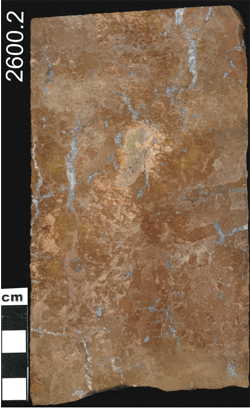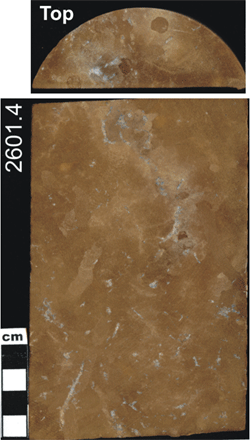Biostabilization of eolian sediment
Samples from Cross H Cattle well |
||
 |
 |
 |
| Root traces filled with anhydrite in burrowed, vfg sandstone. Note gray iron depletion zone enveloping rooted areas and darkened red band of hematite accumulation from surface water gleying. | Root traces filled with anhydrite and calcite cement rimmed rhizoliths in coarse siltstone. Network of fine root traces is well preserved; moderately burrowed. | Root traces filled with anhydrite in burrowed, vfg sandstone. Top view shows cylindrical form of root traces as well as cross section of burrow. |
Stabilization Mechanism
We propose that the coarser eolian sediments were stabilized by vegetative cover and assisted by grain packing of burrowing organisms, probably insects. This allowed for aggradation of eolian siliciclastic sediments.
Evidence
- Root traces in coarse siltstones and sandstones
- Sufficient quantity to suggest vegetative cover
- Sandstone is heavily burrowed wherever it is preserved
- Plants and burrowing animals coexisted (cross-cutting relationships)
Mechanisms at play in accumulation of continental siliciclastics
- Accumulation related to accommodation below sea level accounts for a small portion of the interval (tidal flat, marsh, salina and ephemeral lake deposits).
- There is no evidence that siliciclastics are fluvial (alluvial) with accommodation produced by a rising equilibrium gradient over a low relief surface.
- Though there is evidence of established water tables, the coarser eolian siliciclastics are not interpreted to have been stabilized by a rising water table associated with a rising sea level. Minor lake deposits may have been deposited because of rising water table from increasingly humid climates, or from sea-level rise.
- Some of the coarser siliciclastics (interpreted as eolian) were stabilized by a rising water table associated with increased rainfall.
- The majority of the coarse siliciclastics are eolian and accumulation was made possible through biostabilization by plants and animals.
Relative importance of mechanisms
Accumulation through accommodation below sea level (tidal flat, marsh, salina and ephemeral lake deposits) is approximately equal in thickness in updip and marginally downdip settings. Most of the coarser siliciclastics (very fine-grained sandstones and coarse-grained siltstones) were stabilized by plants and burrowing animals. These sediments account for approximately 50% of the volume at mid-shelf and 80% at the updip margin of the field where eolianites dominate.
http://www.kgs.ku.edu/PRS/AAPG2005/2005-25/p3-01.html
Last Modified November 2005